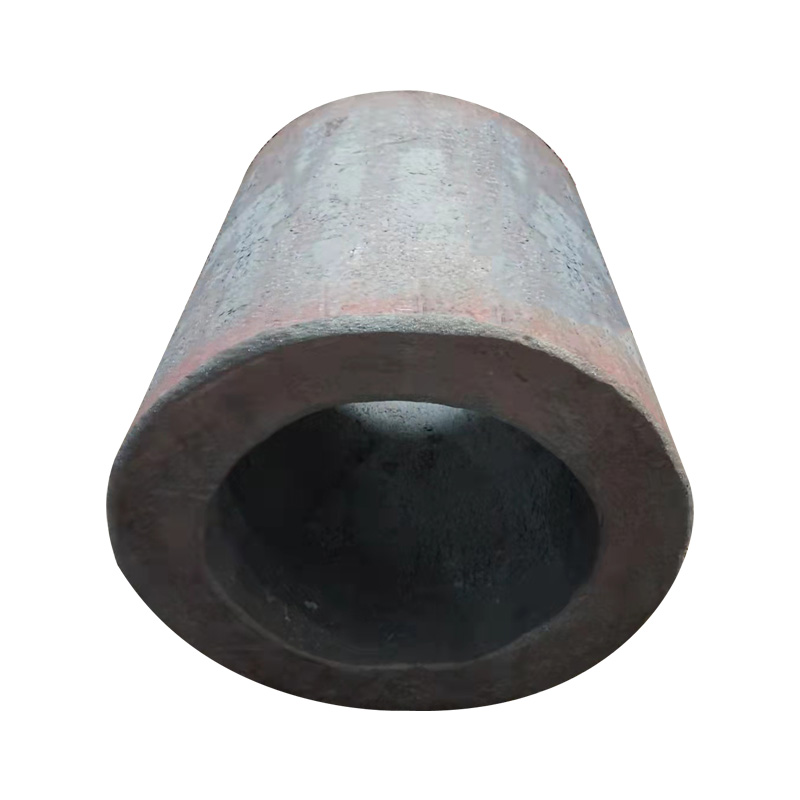What are the characteristics of forging hardening?
2022-07-19
An important characteristic of forgings quenching is the simultaneous cooling of the inner and outer walls. Forgings internal and external medium flow state is different, so that the heat transfer of the inner wall is lower than the outer wall, combined with the fan-shaped characteristics of the forgings cross section, so that the ratio of unit volume and heat exchange surface area of the inner wall is always greater than the outer wall, even if the heat transfer coefficient of the inner and outer wall is close, the cooling of the inner wall is slower than the outer wall.
When the size of forgings is certain, the cooling process of forgings quenching is mainly determined by the temperature and flow state of water. The flow state of water includes velocity and direction of flow. The cooling strength of forgings during quenching is the reflection of heat conduction and convective heat transfer between the surface of forgings and water.
Quenching cooling of forgings is the result of surface heat transfer and internal heat conduction. Improving the surface cooling intensity can accelerate the surface cooling rate.
Wall thickness has a great influence on cooling, and the thinner the wall thickness is, the greater the influence is. Therefore, when quenching, the minimum wall thickness should be taken, especially for forgings with thin wall thickness. When increasing the quenching wall thickness, the effect on the cooling rate should be fully considered.
There are two ways of forging induction surface heating: continuous mobile and fixed, continuous movement method is the sensor or forging side heating side moving then in the move closely followed by the side cooling quenching. The fixed type is the forgings heating quenching surface in the inductor, inductor and forgings have no relative movement, to be heated to the temperature and then spray cooling or the whole forgings into the cooling medium quenching.
Fixed heating is limited by the power of the equipment, and sometimes in order to heat the forgings exceeding the power limit, and to reach a certain depth of hardened layer, the method of repeated heating or preheating to 600℃ is used.
Forgings induction heating using continuous mobile heating is more common, high-frequency quenching heating is usually fixed inductor and forgings move. Medium frequency and power frequency heating, often moved by inductor, forgings can rotate when required. The inductor is arranged on the moving platform of the quenching machine tool.
Quenching temperature depends on the selection of power and moving speed, because the operation area of continuous moving heating is small, the application scope of forgings is relatively wide, so, at present at home and abroad in the induction heating forgings, generally adopt high power medium and low induction heating method.

When the size of forgings is certain, the cooling process of forgings quenching is mainly determined by the temperature and flow state of water. The flow state of water includes velocity and direction of flow. The cooling strength of forgings during quenching is the reflection of heat conduction and convective heat transfer between the surface of forgings and water.
Quenching cooling of forgings is the result of surface heat transfer and internal heat conduction. Improving the surface cooling intensity can accelerate the surface cooling rate.
Wall thickness has a great influence on cooling, and the thinner the wall thickness is, the greater the influence is. Therefore, when quenching, the minimum wall thickness should be taken, especially for forgings with thin wall thickness. When increasing the quenching wall thickness, the effect on the cooling rate should be fully considered.
There are two ways of forging induction surface heating: continuous mobile and fixed, continuous movement method is the sensor or forging side heating side moving then in the move closely followed by the side cooling quenching. The fixed type is the forgings heating quenching surface in the inductor, inductor and forgings have no relative movement, to be heated to the temperature and then spray cooling or the whole forgings into the cooling medium quenching.
Fixed heating is limited by the power of the equipment, and sometimes in order to heat the forgings exceeding the power limit, and to reach a certain depth of hardened layer, the method of repeated heating or preheating to 600℃ is used.
Forgings induction heating using continuous mobile heating is more common, high-frequency quenching heating is usually fixed inductor and forgings move. Medium frequency and power frequency heating, often moved by inductor, forgings can rotate when required. The inductor is arranged on the moving platform of the quenching machine tool.
Quenching temperature depends on the selection of power and moving speed, because the operation area of continuous moving heating is small, the application scope of forgings is relatively wide, so, at present at home and abroad in the induction heating forgings, generally adopt high power medium and low induction heating method.

Previous:Spray quenching process for forging
X
We use cookies to offer you a better browsing experience, analyze site traffic and personalize content. By using this site, you agree to our use of cookies.
Privacy Policy



